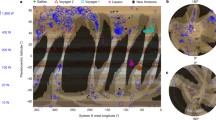Abstract
Generation of artificial light in the sky by means of high-power radio waves interacting with the ionospheric plasma has been envisaged since the early days of radio exploration of the upper atmosphere, with proposed applications ranging from regional night-time street lighting to atmospheric measurements1. Weak optical emissions have been produced for decades in such ionospheric ‘heating’ experiments, where they serve as key indicators of electron acceleration, thermal heating, and other effects of incompletely understood wave–particle interactions in the plasma under conditions difficult to replicate in the laboratory2. The extremely low intensities produced previously have, however, required sensitive instrumentation for detection, preventing applications beyond scientific research. Here we report observations of radio-induced optical emissions bright enough to be seen by the naked eye, and produced not in the quiet mid-latitude ionosphere, but in the midst of a pulsating natural aurora. This may open the door to visual applications of ionospheric heating technology or provide a way to probe the dynamics of the natural aurora and magnetosphere.



Similar content being viewed by others
References
Bailey, V. A. On some effects caused in the ionosphere by electric waves, Part II. Phil. Mag. 26(7), 425–453 (1938)
Bernhardt, P., Duncan, L. M. & Tepley, C. A. Artificial airglow excited by high-power radio waves. Science 242, 1022–1027 (1988)
Chamberlain, J. W. Physics of the Aurora and Airglow (International Geophysics Series Vol. 2, Academic, New York, 1961)
Rishbeth, H. & Garriot, O. K Introduction to Ionospheric Physics (Academic, New York, 1969)
Djuth, F. T. et al. Large airglow enhancements produced via wave-plasma interactions in sporadic E. Geophys. Res. Lett. 26, 1557–1560 (1999)
Omholt, A. The Optical Aurora 6 (Physics and Chemistry in Space Vol. 4, Springer, New York, 1971)
Sergienko, T., Kornilov, I., Belova, E., Turunen, T. & Manninen, J. Optical effects in the aurora caused by ionospheric HF heating. J. Atmos. Sol-Terr. Phys. 59, 2401–2407 (1997)
Blagoveshchenskaya, N. F. et al. Ionospheric HF pump wave triggering of local auroral activation. J. Geophys. Res. 106, 29071–29089 (2001)
Bauer, S. J. Physics of Planetary Ionospheres 82–95 (Physics and Chemistry in Space Vol. 6, Springer, New York, 1973)
Davis, N. The Aurora Watchers Handbook 58 (Univ. Alaska Press, Fairbanks, 1992)
Carlson, H. C. Jr & Egeland, A. in Introduction to Space Physics (eds Kivelson, M. G. & Russell, V.) 459–502 (Cambridge Press, New York, 1995)
Acknowledgements
HAARP is a Department of Defense programme operated jointly by the US Air Force and US Navy. We thank E. Mishin for his contributions to the experiment planning and P. Ning for operating the all-sky imager.
Author information
Authors and Affiliations
Corresponding author
Ethics declarations
Competing interests
The authors declare that they have no competing financial interests.
Rights and permissions
About this article
Cite this article
Pedersen, T., Gerken, E. Creation of visible artificial optical emissions in the aurora by high-power radio waves. Nature 433, 498–500 (2005). https://doi.org/10.1038/nature03243
Received:
Accepted:
Issue Date:
DOI: https://doi.org/10.1038/nature03243
- Springer Nature Limited
This article is cited by
-
Past, Present and Future of Active Radio Frequency Experiments in Space
Space Science Reviews (2018)
-
Anthropogenic Space Weather
Space Science Reviews (2017)
-
Artificial ionosphere creates bullseye in the sky
Nature (2009)
-
Radio waves make aurora sparkle
Nature (2005)





